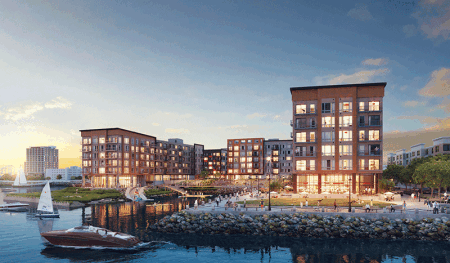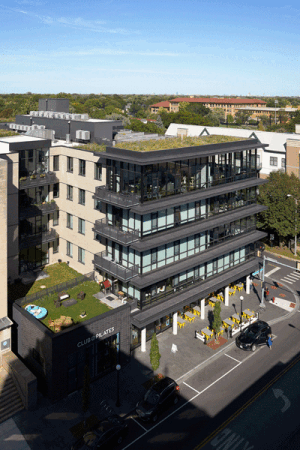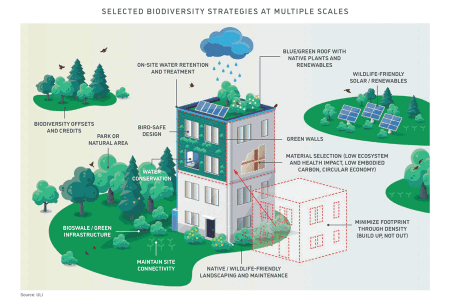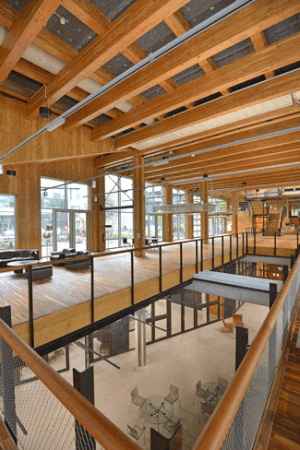Since 1970, wildlife populations have declined by 68 percent. Between 1992 and 2014, economic capital rose by 13 percent per person even as the stock of natural capital fell by 40 percent. Both trends coincided with rapid growth of urban areas, which have more than doubled in size in the past 30 years.
Although the real estate sector played a major role in creating this environmental crisis, the ULI Greenprint Center for Building Performance and the Jacobs argue in a new joint report that advances in technology and environmental science mean that the industry now has an opportunity to be part of the solution. The report, Nature Positive and Net Zero: The Ecology of Real Estate, offers a comprehensive view of how some sustainability-focused developers and asset managers are developing properties in ways that enhance biodiversity.
The authors have both bad news and good news about developing with biodiversity in mind. The bad news is that projects that include a biodiversity component are a lot more complex to design and build than projects that simply limit carbon emissions. The good news is that it is now not only possible to build greener, healthier projects, but also that many of the suggested measures can even make the owner money. Several developers told the authors that building for biodiversity not only has lowered their environmental risks, but also has enhanced the attractiveness and value of their properties.
Carrots and Sticks
A number of factors are encouraging developers to try to bring Mother Nature on as a partner.
On the carrot side, some governments are offering incentives to build green. In Singapore, for example, the government covers 50 percent of the cost of installing green roofs and walls. Using both the subsidy and rules that require replacement of any greenery lost during construction, the city intends to triple its total square footage of green walls and rooftop greenery by 2030.
There are sticks as well, which are also helping to keep builders focused on their carbon footprint. The Biodiversity Net Gain regulation, for instance, that will soon be going into effect in the United Kingdom requires developers to make a 10 percent net gain in biodiversity as a condition of obtaining planning approval in all new developments across England and Wales. Many cities, too, from Malmö, Sweden, to Seattle, Washington, have green space ratios that cannot be ignored.
New voluntary biodiversity disclosure frameworks that resemble carbon disclosure frameworks are also on the way. Two of the most popular are the Taskforce on Nature-related Financial Disclosures (TNFD) and Science Based Targets for Nature (SBTN). While these bioversity disclosure frameworks are technically voluntary, the report suggests that not filling them out may become increasingly expensive for anyone trying to sell to institutional investors.
“The investor space is pretty active in asking us what we’re doing on biodiversity. The conversation has turned from, ‘What are you doing in the carbon space?’ to, ‘What are you doing in the biodiversity space?’ That’s obviously putting us in a position where we need to be on our front foot,” says Darryl Stuckey, head of sustainability transformation–environment, for Lendlease, a $10 billion multi-national construction and property company based in Sydney, Australia.
AEW, the $91.6 billion property fund manager, now offers biodiversity planning as a core part of its advisory process. “We don’t own the building, but we assess biodiversity impacts of the asset—the building and land around it—and we come up with recommendations to improve the biodiversity status of the asset and incorporate this action plan in the improvement plan of the asset’s 10-year capex fund,” says Thierry Laquitaine, head of socially responsible investing for the fund. “We include biodiversity questions in our ESG [environmental, social, and governance] audits, and scoring that must be assessed by an external auditor as well as a specific biodiversity audit for existing and new construction.”
A Challenging Mission
The general concept of encouraging nature to bloom might seem simple, but developers say that in practice, building for biodiversity is extremely challenging.
To begin with, developers must conduct a kind of census of the life they already have on their property.
Often such a survey will include details about what animals have been living in the area, including mammals, reptiles, amphibians, birds, and pollinators; information about the native plants; and measures of soil, air, and water quality—numbers that become the baseline for key performance indicators of biodiversity.
Getting all that down on paper is not easy, even for a major company. “From a measurement and metrics perspective, we are still working to understand the direct and indirect impacts of our business on biodiversity,” Stuckey says.
Fortunately, some metric frameworks are available, such as the Biodiversity Metric 3.1, which was developed by the United Kingdom’s Department for Environment, Food, and Rural Affairs, and the Integrated Biodiversity Assessment Tool, which was developed by the IBAT Alliance, a nongovernmental organization sponsored by Birdlife International, Conservation International, the International Union for the Conservation of Nature, and the United Nations Environment World Conservation Monitoring Centre.
Often, developers find they have many options available to them that could enhance their property’s biodiversity—so many that Grosvenor, the $36.7 billion British property group, assembled a “Biodiversity Buffet,” a 27-page PDF guide to give its managers a sense of the many eco-friendly development options they could pursue, ranging from green roofs and vertical gardens to bird and bat boxes.
As with many development projects, the next step Grosvenor planners take is to rank which measures yield the highest return—biodiversity return, that is—and pursue the one that seems most beneficial.Other developers argue that it is a good idea to include residents in biodiversity decisions and find out what matters most to them. If asthma is prevalent among the resident population, for instance, a measure that targets air quality may be popular, the report advises.
Such interventions can make a difference. At Grosvenor Square, the second-largest garden in London, biodiversity is set to increase 15.5 percent after gardeners add 26 tree species and five times the current number of plant species. Grosvenor’s Holbein Gardens, a 1980s-era London office property, will be retrofitted to reach net zero emissions. Beyond that, the addition of green space inside and more landscaping on the ground floor should yield a 200 percent gain in biodiversity, Grosvenor executives estimate.
Other Initiatives
And Grosvenor is not alone. Among other industry initiatives are the following:
- Lendlease has made improvements to its Clippership Wharf development in Boston, which willgive the neighborhood Leadership in Energy and Environmental Design (LEED) v4 Silver certification while remaking the shoreline so it is both more accessible to the public and better protected from sudden storms.
- In Barangaroo Headland Park in Sydney, Lendlease is transforming a former industrial site into a 15-acre (6 ha) park that features 75,000 native Australian plants and native Australian bees to support pollination. In addition, the developer is enhancing the marine habitat in a number of ways, including installing offshore 384 tiles made of oyster shells and crushed sandstone. After just one year, seaweed as well as large and small fish have already found their way into the area.
- In Northamptonshire, United Kingdom, Prologis is developing not only RFI DIRFT, a 700-acre (283 ha) intermodal freight logistics park—hardly new territory for the $99.6 billion industrial real estate giant—but also Lilbourne Meadows, a diverse 193-acre (78 ha) community composed chiefly of oystercatchers, lapwings, little ringed plovers, skylarks, meadow pipits, and some rare breeds of sheep.
Experts Need Apply
Developing land for nature requires new kinds of expertise unfamiliar to most builders. Many real estate developers say they have had to hire bio-diversity consultants or form partnerships with environmental nonprofit groups. Prologis, for instance, brought in the Wildlife Trust to design and manage Lilbourne Meadows.
Multiple interviewees told Greenprint analysts they have found that bringing a trained ecologist or biologist on board from the start had been essential to the success of their biodiversity projects. “In our current and upcoming projects, we’re seeing how important it is to have biodiversity consultants, landscape architects, and ecologists at the design table,” says Dave Mellor, director of development management, United Kingdom, for Prologis.
One aspect that often requires local advice is the reintroduction of native plants, which tend to be hardier and require less water and fewer herbicides and fertilizers than other plants. Their only disadvantages, ULI analysts say, are that local nurseries may not have a wide selection of them, landscapers who have studied native plants are still in short supply, and people who have grown up with lawns and trimmed hedges may not appreciate the natural look right away. But these disadvantages can all be addressed through efforts to educate landscapers, nurseries, and the public about a region’s native flora.
Biodiversity-conscious development planners are not neglecting native fauna either. In the United States alone, between 100 million and 1 billion birds smack into glass towers and die each year. Now, developers are beginning to sheath their buildings in bird-friendlier materials, and some cities are requiring owners to dim the lights during migrations.
Easy Being Green
Developers are also going beyond simply enabling nature to thrive. Some have found that adding soil and vegetation to a roof can reduce surface temperatures and lower heating and cooling needs dramatically: one study of Canadian green roofs found they could reduce cooling needs by as much as 75 percent. Another Australian study found that over an eight-month period, solar voltaic arrays performed 3.6 percent better on a green roof than on a conventional roof and 20 percent better at peak times—generating an additional A$2,595 (US$1,891) or 9.5 megawatt-hours’ worth of energy.
Beyond the practical advantages, people also see green rooftops as amenities in their own right. At District House, a 75,000-square-foot (7,000 sq m) mixed-use development incorporating mid-rise condominiums and ground-floor retail space in Oak Park, Illinois, lawned terraces and a rooftop wildflower meadow have proved very popular with residents. In addition to absorbing nearly 30,000 gallons (113,500 liters) of stormwater and providing insulation against extreme temperatures, the terraces may offer condo owners a financial cushion as well: District House units with lawned terraces sold for 12.4 percent more than similar units without terraces, a premium of $95,030 per unit.
“Anytime you can take a square foot of a development project and get multiple functions, you increase the value. It’s a slam dunk for nature-based solutions; green infrastructure is definitely the low-hanging fruit,” says Pete Muñoz, a senior engineer and practice lead at Biohabitats, a U.S. environmental consultancy.
Such previously overlooked options can be found underground as well, particularly in urban areas. Over time, many cities have filled in or otherwise paved over streams, creeks, and wetlands. Exposing that water can reduce flooding, provide more space for nature, and create a new focus for the landscape.In the end, Juan Rovalo, senior ecologist and nature-based solutions strategist at Jacobs, believes that opportunities for biodiversity are everywhere, even in the biggest cities. “[S]omething that nature does perfectly well is to fill voids. Wherever there’s a space, nature will take it. Every single part and piece in the core of the biggest city in the world has an opportunity to recover some functionality and wildlife,” he says.
That breadth of opportunity means that good biodiversity planning is not all that different from traditional development. What matters most is how well a thoughtful design responds to a local need. “The best strategies emerge from an intimate understanding of place—what the place is, where it’s nested, and what’s happening there. The ecological components or attributes of a given place should be viewed as assets, not constraints,” Rovalo adds.
BENNETT VOYLES is a Berlin-based business writer.
This article is drawn from Nature Positive and Net Zero: The Ecology of Real Estate, a research paper on biodiversity and the real estate industry by the ULI Greenprint Center for Building Performance and the Jacobs Engineering Group.
More on this topic: Advancing the Roadmap to Nature Positive in the Built Environment









